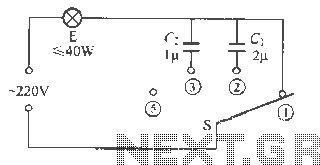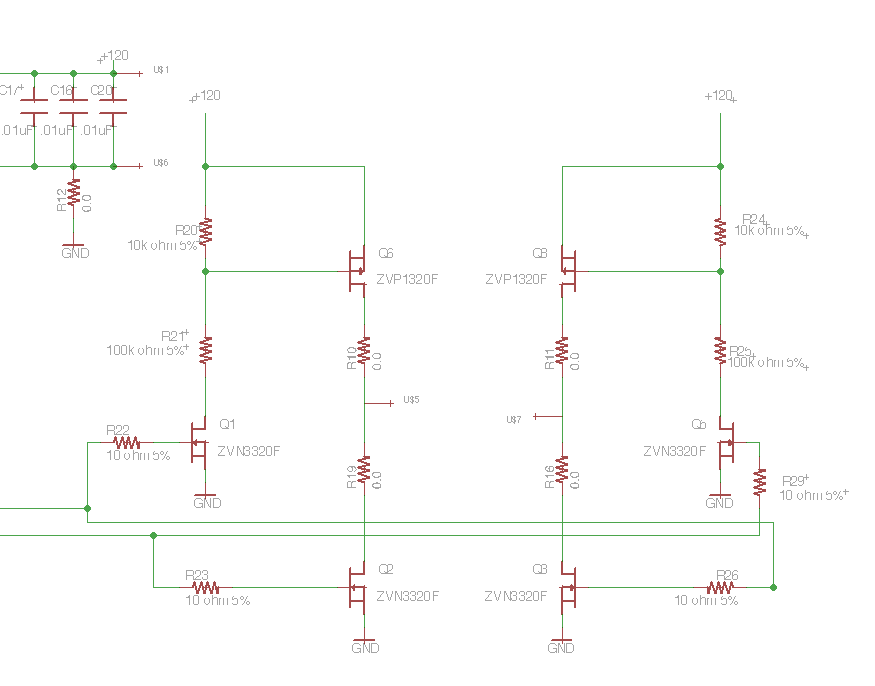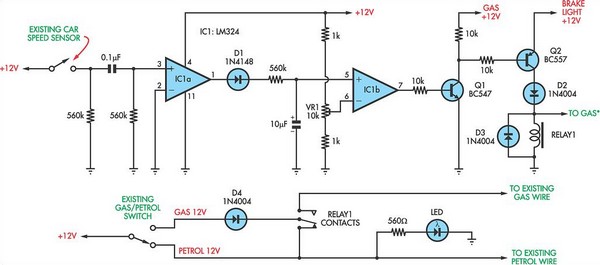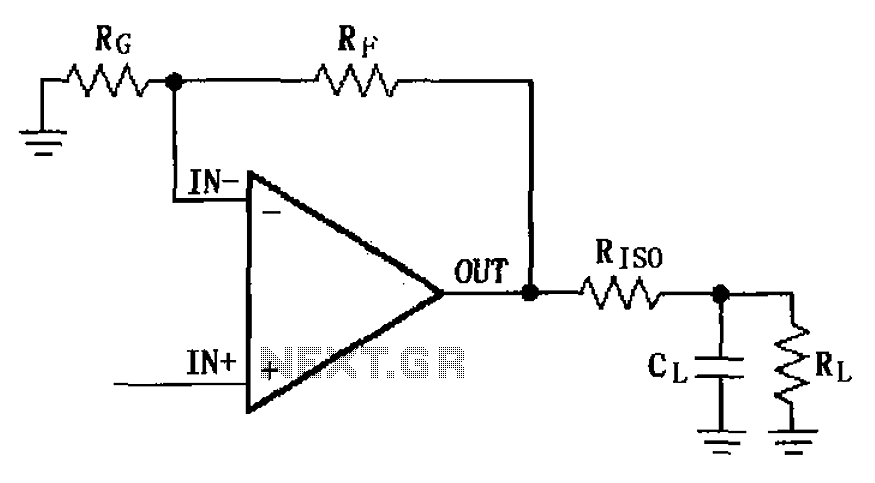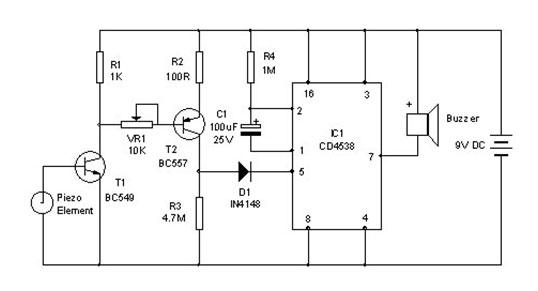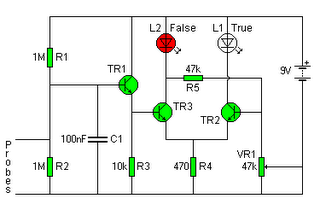
Capacitive SensorCircuit
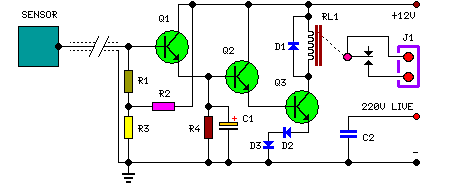
The purpose of this circuit is to animate shop windows using a capacitive sensor placed behind a postcard-like banner. The card is positioned against the glass inside the shop window, allowing visitors to activate the relay by placing their hand on the card from outside. This circuit is particularly suitable for toy shops, as it can activate model trains, small electric racing cars, lights, and more. Additional applications can be explored based on user creativity. It can be adapted to enhance the visual appeal of shop windows, especially during the Christmas season. Q1, Q2, and Q3 form a high-impedance super-Darlington configuration that drives the relay, amplifying the 50 or 60Hz alternating mains supply frequency induced in the sensor by the human body. C1, D2, and D3 ensure clean relay switching. The power supply can be any commercial wall plug-in transformer adapter with a rectifier and smoothing capacitor, capable of providing the necessary voltage and current to power the intended relay.
This circuit design utilizes a capacitive sensor that detects the presence of a human hand, which serves as a trigger for various animated elements in a shop window display. The capacitive sensor operates by measuring changes in capacitance caused by the proximity of a conductive object, such as a human hand. When the hand approaches the postcard-like banner, the sensor detects the change and activates the relay.
The high-impedance super-Darlington configuration formed by transistors Q1, Q2, and Q3 is crucial for amplifying the small signals generated by the sensor. This configuration allows for a significant increase in current gain, enabling the circuit to drive larger loads, such as relays, without requiring substantial input current. The use of a super-Darlington arrangement enhances the sensitivity and response time of the circuit, making it highly effective for shop window applications.
Capacitor C1, along with diodes D2 and D3, plays an essential role in ensuring that the relay operates smoothly and without bouncing. C1 acts as a filter to stabilize the voltage at the relay's coil, while D2 and D3 protect against back EMF generated when the relay is de-energized, preventing potential damage to the circuit components.
The power supply for this circuit is flexible, allowing for the use of a standard wall plug-in transformer adapter. This adapter must be equipped with a rectifier and smoothing capacitor to convert the AC mains supply into a stable DC voltage suitable for the relay and other circuit components. The selection of the power supply should consider the voltage and current ratings required by the specific relay being used, ensuring reliable operation of the overall circuit.
In summary, this circuit provides an innovative method for animating shop windows, leveraging capacitive sensing technology to engage customers and enhance the shopping experience. Its versatility allows for various creative applications, making it an excellent choice for seasonal promotions and retail displays.The purpose of this circuit is to animate shop-windows by means of a capacitive sensor placed behind a post-card-like banner. The card is placed against the glass inside the shop-window, and the visitor can activate the relay placing his hand on the card, from the outside.
Especially suited for toy-shops, the circuit can activate model trains, sma ll electric racing cars, lights etc. Further applications are left at user`s imagination. Adopt it to increase the impact of your shop-window on next Christmas season! Q1, Q2 & Q3 form a high impedance super-Darlington that drives the relay, amplifying the 50 or 60Hz alternate mains-supply frequency induced in the sensor by the human body. C1, D2 & D3 ensure a clean switching of the relay. Power supply can be any commercial wall plug-in transformer adapter with rectifier and smoothing capacitor, capable of supplying the voltage and current necessary to power the relay you intend to use.
🔗 External reference
This circuit design utilizes a capacitive sensor that detects the presence of a human hand, which serves as a trigger for various animated elements in a shop window display. The capacitive sensor operates by measuring changes in capacitance caused by the proximity of a conductive object, such as a human hand. When the hand approaches the postcard-like banner, the sensor detects the change and activates the relay.
The high-impedance super-Darlington configuration formed by transistors Q1, Q2, and Q3 is crucial for amplifying the small signals generated by the sensor. This configuration allows for a significant increase in current gain, enabling the circuit to drive larger loads, such as relays, without requiring substantial input current. The use of a super-Darlington arrangement enhances the sensitivity and response time of the circuit, making it highly effective for shop window applications.
Capacitor C1, along with diodes D2 and D3, plays an essential role in ensuring that the relay operates smoothly and without bouncing. C1 acts as a filter to stabilize the voltage at the relay's coil, while D2 and D3 protect against back EMF generated when the relay is de-energized, preventing potential damage to the circuit components.
The power supply for this circuit is flexible, allowing for the use of a standard wall plug-in transformer adapter. This adapter must be equipped with a rectifier and smoothing capacitor to convert the AC mains supply into a stable DC voltage suitable for the relay and other circuit components. The selection of the power supply should consider the voltage and current ratings required by the specific relay being used, ensuring reliable operation of the overall circuit.
In summary, this circuit provides an innovative method for animating shop windows, leveraging capacitive sensing technology to engage customers and enhance the shopping experience. Its versatility allows for various creative applications, making it an excellent choice for seasonal promotions and retail displays.The purpose of this circuit is to animate shop-windows by means of a capacitive sensor placed behind a post-card-like banner. The card is placed against the glass inside the shop-window, and the visitor can activate the relay placing his hand on the card, from the outside.
Especially suited for toy-shops, the circuit can activate model trains, sma ll electric racing cars, lights etc. Further applications are left at user`s imagination. Adopt it to increase the impact of your shop-window on next Christmas season! Q1, Q2 & Q3 form a high impedance super-Darlington that drives the relay, amplifying the 50 or 60Hz alternate mains-supply frequency induced in the sensor by the human body. C1, D2 & D3 ensure a clean switching of the relay. Power supply can be any commercial wall plug-in transformer adapter with rectifier and smoothing capacitor, capable of supplying the voltage and current necessary to power the relay you intend to use.
🔗 External reference
